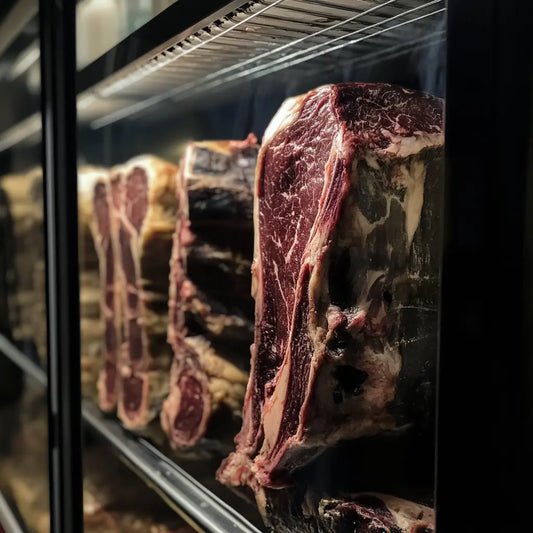
What is Dry-Aged Steak & How Does It Taste?
Share
Did you know that some dry-aged steaks are aged for over 120 days, creating flavours impossible to find in fresh beef? This careful process develops a unique taste that’s rich, nutty, and deeply beefy, attracting chefs and steak lovers alike.
Unlike fresh or wet-aged beef, dry-aged steak goes through a controlled aging process where natural enzymes break down muscle fibres to improve tenderness. At the same time, moisture evaporates, concentrating the beef’s natural flavours.
At Chef's Culture, we offer premium dry-aged ribeye and striploin, made from top-quality Ontario beef. Whether you’re a home cook or a professional chef, our dry-aged steaks provide the bold flavour and tenderness you expect from exceptional cuts.
Key takeaways
- Dry-aged steak undergoes a controlled aging process to improve flavour and tenderness
- The taste is nutty, earthy, buttery, and intensely beefy
- Chef's Culture offers premium dry-aged Ontario ribeye and striploin for home cooks and chefs
What is dry-aged steak?
Dry-aged steak refers to beef cuts that have been stored in a controlled environment for several weeks or even months. Unlike wet aging, where beef is vacuum-sealed, dry aging exposes the meat to air, allowing natural enzymes to break down muscle tissue. This process enhances tenderness and concentrates flavour.
Dry aging typically lasts anywhere from 21 to 120 days. The longer the steak ages, the more intense and complex its flavours become.
The dry aging process
Dry aging requires strict control of temperature, humidity, and airflow. The meat is stored at near-freezing temperatures (usually around 1 to 3°C) with humidity levels between 80% and 85%. Consistent air circulation is essential to prevent spoilage and promote even aging.
As the steak ages:
- Enzymes break down muscle fibres, improving tenderness
- Moisture evaporates, concentrating the beef’s natural flavours
- The outer layer forms a crust, which is trimmed before cooking
At Chefs Culture, we carefully monitor each step of this process to ensure consistent, high-quality results with every cut of meat.
How does dry-aged steak taste?
The flavour of dry-aged steak is unlike any other. Common tasting notes include:
- Nutty and buttery tones
- Earthy depth
- Umami-rich beefiness
As the aging period increases, these flavours intensify. A steak aged for 21 to 45 days typically has a balanced richness, while cuts aged beyond 60 days develop bold, blue cheese-like notes that appeal to adventurous palates.
Compared to fresh or wet-aged steaks, dry-aged beef offers a deeper, more complex flavour and a tender, buttery texture.
Popular cuts used for dry aging
Not all cuts are ideal for dry aging. The best candidates are large, well-marbled cuts, including:
- Ribeye
- Striploin
- Sirloin
These cuts have enough fat content and size to retain moisture and develop flavour during the aging process. At Chef's Culture, our dry-aged ribeye and striploin are among the most popular choices, prized for their marbling and rich taste.
Benefits of dry-aged steak
Dry-aged steak offers several advantages:
- Superior tenderness due to enzyme activity
- Concentrated, complex flavours
- Prestige and enhanced dining experience for discerning meat lovers
Whether you're preparing a special dinner or adding a premium offering to your menu, dry-aged steak stands out for its quality and taste.
Common misconceptions about dry-aged steak
Despite its popularity, some misconceptions persist:
- Dry-aged steak is not spoiled meat. The aging process is carefully controlled to prevent spoilage.
- Longer aging isn’t always better. While some prefer the bold flavours of extensively aged beef, others favour a milder profile.
- The price reflects the complexity and time of the process, not just exclusivity. Dry aging involves significant weight loss and time investment.
How to cook dry-aged steak
Cooking dry-aged steak is about letting the natural flavours shine:
- Grill, pan-sear, or broil to develop a caramelized crust
- Minimal seasoning — coarse salt and freshly cracked pepper are usually enough
- Rest the steak after cooking to retain juices
Avoid overcooking, as the reduced moisture content can make dry-aged steak less forgiving than fresher cuts.
Where to buy dry-aged steak
Dry-aged steak is available from:
- Specialty butchers
- High-end steakhouses
- Online meat shops
For those seeking expertly crafted dry-aged steak in Ontario, Chef's Culture offers premium dry-aged ribeye and dry-aged striploin. Our beef is carefully sourced and aged to meet the expectations of both home cooks and professional chefs.
Buy dry-aged steak online
Dry-aged steak delivers a unique culinary experience with its tender texture and deep, complex flavours. Whether you're an experienced chef or simply passionate about great steak, choosing high-quality dry-aged beef makes all the difference. At Chef's Culture, we proudly offer dry-aged ribeye and striploin made from premium Ontario beef, ensuring every bite is a memorable one.
Frequently asked questions (FAQs) about dry-aged steak
What does dry-aged steak taste like?
Dry-aged steak has a deep beef flavour with nutty, earthy, and umami-rich notes.
How long should steak be dry-aged?
Most steaks are aged between 21 and 45 days, though some are aged up to 120 days for more intense flavours.
Is dry-aged steak worth the cost?
Many steak lovers believe the enhanced flavour and tenderness justify the premium price.
Can you dry age steak at home?
Yes, but it requires specialized equipment and strict control of temperature, humidity, and airflow.




